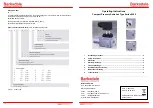
Chapter 1 Introduction and Planning
1-11
cable and components as specified in these standards. In addition, your network
will operate on IBM Cabling System types 1, 6, and 9, 150-ohm STP or STP-A
cable. If you are using 150-ohm cabling systems, impedance-matching devices
must be used in conjunction with the cable.
Your 10BASE-T network will also operate correctly on category 3, 4, or 5, 100- and
120-ohm, balanced, shielded or unshielded cables and components as specified in
the ISO/IEC 11801 standard. It will also operate on 150-ohm, balanced, shielded
cables and components as specified in the ISO/IEC 11801 standard. In addition,
your network will operate on any link that meets the specifications of a Class D link
as specified in the standard; this includes IBM Cabling System type 9 STP cabling.
If you are using 120- or 150-ohm cabling systems, impedance-matching devices
must be used in conjunction with the cable.
All devices connected to the cables must be grounded.
Do not use telephone extension cables in 10BASE-T networks. The wire pairs in
those cables are not twisted and the cable does not meet other requirements for use
in a 10BASE-T network.
Applicable Cabling Standards
In the United States, the
ANSI/TIA/EIA 568-A Commercial Building
Telecommunications Standard
has been widely adopted. The Canadian Standards
Association has also participated in the development of this standard and issues a
parallel document known as T529; the most current version of this document is
dated 1995. Many other countries use
ISO/IEC 11801 Information technology -
Generic cabling for customer premises
.
It is good practice to use only those components that have been certified by an
independent testing laboratory as meeting one or more of the standards. In the
case of IBM Cabling System types 1, 6, and 9 cable, certification should be either to
the IBM specification or to the applicable standard.
Cabling Requirements for the Expansion Ports
Cable and connector requirements differ depending on the Expansion Port you use.
AUI/10BASE2 Media Expansion Port
This Media Expansion Port incorporates a BNC connector plus an AUI port. Only
one port can be used at a time, and the port type selection is made with the push
button on the Expansion Port front panel. For connection to 10BASE2 networks,
you should use RG-58 A/U coaxial cables meeting the specifications in TIA/EIA
568A or ISO/IEC 11801. The maximum length of coaxial cable in one segment
should not exceed 185 m (607 ft) and the number of attached nodes should not
exceed 30. Connection to other networks, such as 10BASE5, can be made via the
appropriate transceiver attached to the AUI port.
10BASE-FL/FOIRL Media Expansion Port
This Media Expansion Port incorporates two ST connectors. Use 62.5/125-micron
multimode optical fiber that meets the specifications in TIA/EIA 568A or ISO/IEC
11801. The maximum length of optical fiber cable between devices should not
exceed 2000 m (6561 ft). This device also supports FOIRL. The maximum distance
for FOIRL interconnection is 1000 m (3280 ft).
Summary of Contents for 8237
Page 1: ......
Page 2: ......
Page 7: ...vi 8237 Hub Installation and Planning Guide...
Page 15: ...xiv 8237 Hub Installation and Planning Guide...
Page 41: ...2 8 8237 Hub Installation and Planning Guide...
Page 91: ...3 50 8237 Hub Installation and Planning Guide...
Page 109: ...4 18 8237 Hub Installation and Planning Guide Figure 4 20 8237 Field Replaceable Parts...
Page 113: ...4 22 8237 Hub Installation and Planning Guide...
Page 117: ...A 4 8237 Hub Installation and Planning Guide...
Page 147: ...B 30 8237 Hub Installation and Planning Guide...
Page 166: ...Part Number 85H8847 Printed in Taiwan 85H8847 GA27 4186 00...
















































